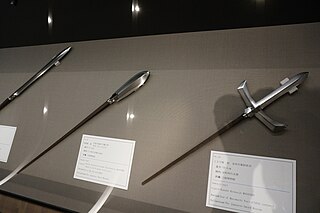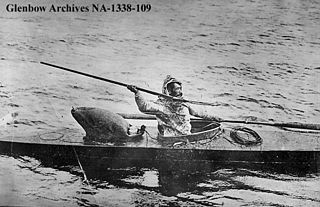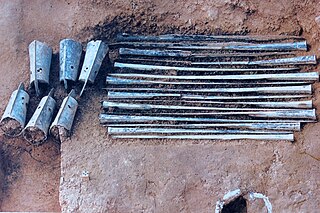Normally thrown
Europe
Elsewhere
- Assegai (Africa)
- Djerid (Asia Minor, India and Africa)
- Toggling harpoon (Americas)
This is a list of types of spears found worldwide throughout history.
A spear is a pole weapon consisting of a shaft, usually of wood, with a pointed head. The head may be simply the sharpened end of the shaft itself, as is the case with fire hardened spears, or it may be made of a more durable material fastened to the shaft, such as bone, flint, obsidian, iron, steel, or bronze. The most common design for hunting or combat spears since ancient times has incorporated a metal spearhead shaped like a triangle, lozenge, or leaf. The heads of fishing spears usually feature barbs or serrated edges.

A pike is a very long thrusting spear formerly used in European warfare from the Late Middle Ages and most of the Early Modern Period, and were wielded by foot soldiers deployed in pike square formation, until it was largely replaced by bayonet-equipped muskets. The pike was particularly well-known as the primary weapon of Swiss mercenary and German Landsknecht units. A similar weapon, the sarissa, had been used in antiquity by Alexander the Great's Macedonian phalanx infantry.

Yari (槍) is the term for a traditionally-made Japanese blade in the form of a spear, or more specifically, the straight-headed spear. The martial art of wielding the yari is called sōjutsu.

Curtisia dentata is a flowering tree from Southern Africa. It is the sole species in genus Curtisia, which was originally classed as a type of "dogwood" (Cornaceae), but is now placed in its own unique family Curtisiaceae.

A harpoon is a long spear-like instrument and tool used in fishing, whaling, sealing, and other marine hunting to catch and injure large fish or marine mammals such as seals and whales. It accomplishes this task by impaling the target animal and securing it with barb or toggling claws, allowing the fishermen to use a rope or chain attached to the projectile to catch the animal. A harpoon can also be used as a weapon. Certain harpoons are made with different builds to perform better with the type of target being aimed at. For example, the Inuit have short, fixed foreshaft harpoons for hunting seals at their breathing holes while loose shafted ones are made for attaching to the game thrown at.

Sōjutsu (槍術), meaning "art of the spear", is the Japanese martial art of fighting with a Japanese spear.

An assegai or assagai is a pole weapon used for throwing, usually a light spear or javelin made up of a wooden handle and an iron tip.

The toggling harpoon is an ancient weapon and tool used in whaling to impale a whale when thrown. Unlike earlier harpoon versions which had only one point, a toggling harpoon has a two-part point. One half of the point is firmly attached to the thrusting base, while the other half of the point is fitted over this first point like a cap and attached to the rest of the point with sinew or another string-like material. When the harpoon is thrust into an animal, the top half of the point detaches and twists horizontally into the animal under the skin, allowing hunters to haul the animal to ship or shore. This harpoon technology lodges the toggling head of the harpoon underneath both the animal's skin and blubber, and instead lodges the point in the muscle, which also prevents the harpoon slipping out.

The kama-yari is essentially a yari with horizontal kama (blade) at the base of the vertical blade to assist in grappling an opponent. Generally, the transverse blade, or hook, is large enough to hold the head, neck, or jaw or to grapple with the limbs of an opponent. It is different in function from other types of yari. The kama-yari was often used to hook horsemen and dismount them.

The two-flue harpoon or two-flue iron is a type of harpoon used in whaling for at least 1000 years. It appears in works of art dating back to the 14th century.
The one-flue harpoon or one-flue iron is a type of harpoon used in whaling after its introduction in the early 19th century when it replaced the two-flue harpoon. Due to the asymmetric design of the head for which it is named, the one-flue harpoon was less likely to cut its way out of the whale meat and blubber, and was therefore more successful in whaling.

A javelin is a light spear designed primarily to be thrown, historically as a ranged weapon, but today predominantly for sport. The javelin is almost always thrown by hand, unlike the sling, bow, and crossbow, which launch projectiles with the aid of a hand-held mechanism. However, devices do exist to assist the javelin thrower in achieving greater distance, such as spear-throwers or the amentum.

Hoko yari is an ancient form of Japanese spear or yari said to be based on a Chinese spear. The hoko yari came into use sometime between the Yayoi period and the Heian period, possibly during the Nara period in the 8th century AD.

Alliat is a commune in the Ariège department and Occitanie region in southwestern France.
Sagaie may refer to:
A flue is a duct, pipe, or chimney for removing exhaust gases to the outdoors.
An assegai is a type of spear.

The Battle of Salt River was a small military engagement between the crew of a Portuguese fleet led by Francisco de Almeida and the indigenous ǃUriǁʼaekua, notable for being the first military encounter between Europeans and indigenous people in what would later become South Africa. The battle resulted in a massacre of Portuguese forces and a victory for the ǃUriǁʼaekua.

The Assegai was a Formula One car built by Tony Kotze under the marque Bond Cars. It was named after an African spear. It was entered for two non-championship Formula One races and various club-level races in South Africa. The Assegai and the LDS are the only Formula One cars to have been built by South African constructors.